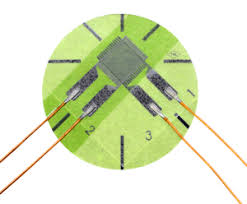Strain gauges
It is a passive transducer. This is a transducer. This transforms mechanical elongation and compression into resistance change. The elongation or compression per unit length of conducting wire is called a strain. The strain gauge is an example of a passive transducer that uses the variation in electrical resistance in wires to since the strain produced by a force on the wires.
It is conducting wire which is stretched or compressed, its resistance will change, because of change in length, area and resistivity of metal wire. The strain gauge is an example of a passive transducer that user the variation in electrical resistance in wires to sense the strain produced by a force on the wires.
Let the resistance ‘R’ of the conductor
‘A’ is the cross-sectional area
L is the length of conductor
P is the resistivity of the material
So the resistance of conducting wire is given by
R=pL/A —————1
The term gauge factor F is defined as
F=(∆R\R)/(∆L\L)=(∆R\R)/E ———-2
Where,
∆R is changed in resistance, ∆L is changed in length of the conductor
From equation 2 we can say, ∆ R being changed in resistance R due to strain which is ∆L/L
Thus with the compressive strain, the value of resistance gauge shows a decrease of 1.2m in the value of resistance. Basic principal on which strain gauge works is that if the material is stretched or compressed, its resistance changes on account of the change in length and diameter of conductor application.
The strain gauge find application in the following area
- Experimental stress analysis
- Load cells
- Torque meters
- Diaphragm type pressure gauge
- Accelerometers
- Flow meters
- Temperature sensors


